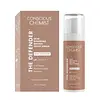What's inside
What's inside
 Key Ingredients
Key Ingredients

 Benefits
Benefits

 Concerns
Concerns

 Ingredients Side-by-side
Ingredients Side-by-side

Water
Skin ConditioningCoco-Caprylate
EmollientBetaine
HumectantPropylene Glycol
HumectantCetearyl Olivate
Sorbitan Olivate
EmulsifyingDimethicone
EmollientBehenyl Alcohol
EmollientBHT
AntioxidantBHA
AntioxidantRetinol
Skin ConditioningPoloxamer 235
EmulsifyingEpigallocatechin Gallate
AntioxidantPolysorbate 20
EmulsifyingDisodium EDTA
Phenoxyethanol
PreservativeSodium Ascorbate
AntioxidantGarcinia Indica Seed Butter
Skin ConditioningPalmitoyl Glycine
CleansingEthylhexylglycerin
Skin ConditioningOctenidine Hcl
AntimicrobialGlyceryl Stearate
EmollientAllantoin
Skin ConditioningDiethylamino Hydroxybenzoyl Hexyl Benzoate
UV FilterCarbomer
Emulsion StabilisingTriethanolamine
BufferingWater, Coco-Caprylate, Betaine, Propylene Glycol, Cetearyl Olivate, Sorbitan Olivate, Dimethicone, Behenyl Alcohol, BHT, BHA, Retinol, Poloxamer 235, Epigallocatechin Gallate, Polysorbate 20, Disodium EDTA, Phenoxyethanol, Sodium Ascorbate, Garcinia Indica Seed Butter, Palmitoyl Glycine, Ethylhexylglycerin, Octenidine Hcl, Glyceryl Stearate, Allantoin, Diethylamino Hydroxybenzoyl Hexyl Benzoate, Carbomer, Triethanolamine
Water
Skin ConditioningCentella Asiatica Extract
CleansingGlycerin
HumectantLecithin
EmollientHelianthus Annuus Seed Oil
EmollientAlcohol
AntimicrobialTocopherol
AntioxidantTrehalose
HumectantPhenoxyethanol
PreservativeCarbomer
Emulsion StabilisingRetinol
Skin ConditioningPolysorbate 20
EmulsifyingBHA
AntioxidantBHT
AntioxidantPanthenol
Skin ConditioningSodium PCA
HumectantSodium Lactate
BufferingArginine
MaskingAspartic Acid
MaskingPCA
HumectantGlycine
BufferingAlanine
MaskingSerine
MaskingValine
MaskingProline
Skin ConditioningThreonine
Isoleucine
Skin ConditioningHistidine
HumectantPhenylalanine
MaskingAcetyl Hexapeptide-8
HumectantCopper Tripeptide-1
Skin ConditioningPalmitoyl Pentapeptide-4
Skin ConditioningTripeptide-1
Skin ConditioningHexapeptide-9
Skin ConditioningPalmitoyl Tripeptide-1
Skin ConditioningPolyglyceryl-10 Laurate
Skin ConditioningButylene Glycol
Humectant1,2-Hexanediol
Skin ConditioningPrunus Armeniaca Bud Extract
Skin ConditioningSodium Hyaluronate
HumectantSaccharide Isomerate
HumectantCitric Acid
BufferingSodium Citrate
BufferingWater, Centella Asiatica Extract, Glycerin, Lecithin, Helianthus Annuus Seed Oil, Alcohol, Tocopherol, Trehalose, Phenoxyethanol, Carbomer, Retinol, Polysorbate 20, BHA, BHT, Panthenol, Sodium PCA, Sodium Lactate, Arginine, Aspartic Acid, PCA, Glycine, Alanine, Serine, Valine, Proline, Threonine, Isoleucine, Histidine, Phenylalanine, Acetyl Hexapeptide-8, Copper Tripeptide-1, Palmitoyl Pentapeptide-4, Tripeptide-1, Hexapeptide-9, Palmitoyl Tripeptide-1, Polyglyceryl-10 Laurate, Butylene Glycol, 1,2-Hexanediol, Prunus Armeniaca Bud Extract, Sodium Hyaluronate, Saccharide Isomerate, Citric Acid, Sodium Citrate
Ingredients Explained
These ingredients are found in both products.
Ingredients higher up in an ingredient list are typically present in a larger amount.
The ingredient "BHA" stands for butylated hydroxyanisole. If you are looking for the beta-hydroxy acid, aka as Salicylic Acid, click here.
In cosmetics, butylated hydroxyanisole is used as a perservative. It also has antioxidant properties. The concentrations usually used in skincare are low and do not penetrate through skin.
It is only considered a carcinogen when ingested.
Butylated Hydroxyanisole is a synthetic and waxy petrochemical. It is used as a preservative in foods and cosmetics.
Learn more about BHABHT is a synthetic antioxidant and preservative.
As an antioxidant, it helps your body fight off free-radicals. Free-radicals are molecules that may damage your skin cells.
As a preservative, it is used to stabilize products and prevent them from degrading. Specifically, BHT prevents degradation from oxidation.
The concerns related to BHT come from oral studies; this ingredient is currently allowed for use by both the FDA and EU.
However, it was recently restricted for use in the UK as of April 2024.
Learn more about BHTCarbomer is a polymer of acrylic acid. Its main role is to create a gel consistency.
A high amount of carbomer can cause pilling or balling up of products. Don't worry, most products contain 1% or less of carbomer.
Phenoxyethanol is a preservative that has germicide, antimicrobial, and aromatic properties. Studies show that phenoxyethanol can prevent microbial growth. By itself, it has a scent that is similar to that of a rose.
It's often used in formulations along with Caprylyl Glycol to preserve the shelf life of products.
Polysorbate 20 is made by combining ethoxylation of sorbitan, ethylene oxide, and lauric acid. It is a mild cleansing agent, surfactant, and emulsifier.
As a surfactant, it helps collect dirt and oils for washing. Emulsifiers prevent oils and water from separating.
Polysorbate 20 also adds scent to a product. Since it is made using sorbitol, it has a sweet scent. Sorbitol can also be found in fruits such as apples and peaches.
The lauric acid used to create Polysorbate 20 is often derived from coconuts.
Polysorbate 20 may not be fungal acne safe.
Learn more about Polysorbate 20Retinol is a gold-standard ingredient for anti-aging. It is a form of Vitamin A and belongs to the class of retinoids that also includes tretinoin.
Why is retinol famous?
It has the most scientific studies backing up its skin benefits out of all the non-prescription ingredients.
Retinol is proven to:
This is why retinol is effective at removing wrinkles, fading dark spots, treating acne, and reducing the appearance of pores.
Studies show retinol is less effective when exposed to UV. Be sure to look for appropriate packaging to keep your retinol potent (similar to Vitamin C).
Using retinol or any retinoids will increase sun-sensitivity in the first few months. Though studies show retinoids increase your skin's natural SPF with continuous use, it is best to always wear sunscreen and sun-protection.
We recommend speaking with a medical professional about using this ingredient during pregnancy.
Retinol may cause irritation in some people, so be sure to patch test. Experts recommend 'ramping up' retinol use: start using this ingredient once a week and work up to using it daily.
Read about Tretinoin
Learn more about RetinolWater. It's the most common cosmetic ingredient of all. You'll usually see it at the top of ingredient lists, meaning that it makes up the largest part of the product.
So why is it so popular? Water most often acts as a solvent - this means that it helps dissolve other ingredients into the formulation.
You'll also recognize water as that liquid we all need to stay alive. If you see this, drink a glass of water. Stay hydrated!
Learn more about Water